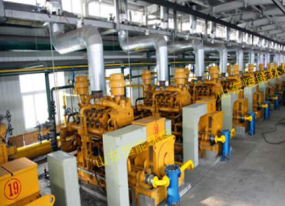湿式氧化法脱硫在生产中经常出现堵塔的现象。
Tower blockage often occurs in wet oxidation desulfurization.
可以说自湿式氧化法脱硫在生产中应用以来,堵塔现象一直伴随其中,虽然随着科学技术的快速发展,许多新型脱硫催化剂已经具备清塔洗堵的能力,使堵塔现象减少,但由于企业的工况、操作和管理等原因,使堵塔现象仍然是行业脱硫目前普遍关注的焦点。多年来我们经过走访、调研并加以总结找出其形成的原因,主要有以下几个方面:
It can be said that the tower blocking phenomenon has been accompanied since the application of wet oxidation desulfurization in production. Although with the rapid development of science and technology, many new desulfurization catalysts have the ability to clean the tower and reduce the tower blocking phenomenon, the tower blocking phenomenon is still the focus of general attention in the desulfurization industry due to the working conditions, operation and management of enterprises. Over the years, we have visited, investigated and summarized to find out the reasons for its formation, mainly in the following aspects:

1、进脱硫塔的气体成分不好,杂质含量较多(如粉煤灰、煤焦油及其它固体颗粒等)。这种现象主要是前工段水洗塔及静电除焦运行不正常造成的。
1. The gas entering the desulfurization tower has poor composition and high impurity content (such as fly ash, coal tar and other solid particles). This phenomenon is mainly caused by the abnormal operation of the water washing tower and electrostatic coke removal in the front section.
2.填料塔在脱硫反应过程时,同时也伴随着氧化再生析硫过程,析出的硫过多(特别是入口H2S含量较高时),不能及时随脱硫液带出脱硫塔,会在填料表面粘结,导致出现局部堵塞,偏流,严重时形成堵塔。
2. The desulfurization reaction process of the packed tower is also accompanied by the oxidation regeneration sulfur precipitation process. Too much sulfur is precipitated (especially when the inlet H2S content is high), which cannot be brought out of the desulfurization tower with the desulfurization liquid in time, which will bond on the surface of the packing, resulting in local blockage, bias flow and tower blockage in serious cases.
3、脱硫塔喷淋密度不够。一般要求在35-50m3/m2.h。较低的喷淋密度不仅会使塔内填料形成干区造成硫堵而且会大大降低脱硫塔的净化度。特别对于直径较大的塔一定要保证足够的贫液量,当遇到减机减量或入口H2S较低时,切不可盲目降低循环量。此时为了降低消耗可采取降低溶液组分的办法来达到目的。
3. The spray density of desulfurization tower is not enough. The general requirement is 35-50m3 / m2 h。 The lower spray density will not only form a dry area of the packing in the tower, resulting in sulfur blockage, but also greatly reduce the purification degree of the desulfurization tower. Especially for the tower with large diameter, sufficient lean liquid volume must be ensured. When the unit is reduced or the inlet H2S is low, the circulation volume must not be reduced blindly. At this time, in order to reduce consumption, the method of reducing solution components can be adopted to achieve the purpose.
4、再生空气量不够(一般要求在60-100m3/m2.h),或再生设备不配套。这种现象必然造成再生槽内硫泡沫浮选困难,使贫液中悬浮硫较高,若长时间运行很容易形成塔堵。
4. The amount of regeneration air is insufficient (generally 60-100m3 / m2. H), or the regeneration equipment is not matched. This phenomenon will inevitably cause the flotation of sulfur foam in regenerative tank difficult, so that the suspended sulfur in the poor liquid is higher, and if long time operation is easy to form tower plugging.
5、脱硫塔的设备结构本身有问题,如填料选择不当或塔的液体分布器、再布器结构或安装不合理。这种现象很容易使溶液偏流或分布槽本身积硫而造成塔堵。
5. There are problems in the equipment structure of the desulfurization tower, such as improper selection of filler or unreasonable structure or installation of liquid distributor and redistributor of the tower. This phenomenon is easy to make the solution bias flow or sulfur accumulation in the distribution tank itself, resulting in tower blockage.
6、副反应物生成的各种盐类物质浓度高,温度低时析出来堵塔。在正常工况下,特别对于管理比较好的厂家(现场没有什么跑、冒、滴、漏),脱硫液中富盐的增加是可以理解的。因为脱硫液在吸收H2S的反应过程中,同时伴随副反应的发生,这是不可避免的,这样溶液在系统内长时间循环必然造成副盐量的积累。虽然在熔硫时带走一部分,但它的量比生成的量小的多。因此,我们相关企业应该正确对待溶液中副盐的含量,当其增加时,要及时采取措施以防盐堵。至于多少含量为超标,各企业因工况不一样,具体指标有所不同。我们一般认为副盐总量不要超过250g/l。
6. When the concentration of various salts generated by the side reactants is high and the temperature is low, they will separate out and block the tower. Under normal working conditions, especially for manufacturers with good management (there is no running, emitting, dripping and leakage on site), the increase of rich salt in desulfurization liquid is understandable. It is inevitable that the desulfurization solution will be accompanied by side reactions in the reaction process of absorbing H2S. In this way, the long-term circulation of the solution in the system will inevitably lead to the accumulation of by-salt. Although some sulfur is taken away during melting, its amount is much smaller than that generated. Therefore, our relevant enterprises should correctly treat the content of by-salt in the solution. When it increases, we should take timely measures to prevent salt blockage. As for how much content exceeds the standard, each enterprise has different specific indicators due to different working conditions. We generally believe that the total amount of by-salt should not exceed 250G / L.
以上就是为大家介绍的有关
湿法脱硫的详细介绍,希望对您有所帮助.如果您有什么疑问的话,欢迎联系我们.我们将以专业的态度,为您提供服务
The above is the detailed introduction of wet desulfurization, which I hope will be helpful to you If you have any questions, please contact us We will provide you with professional service
